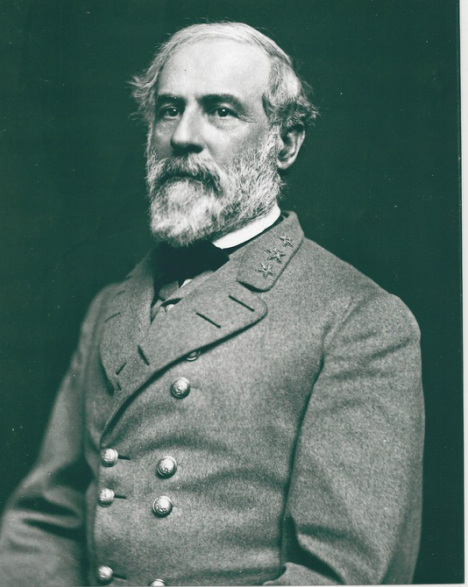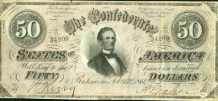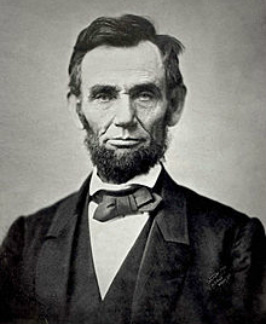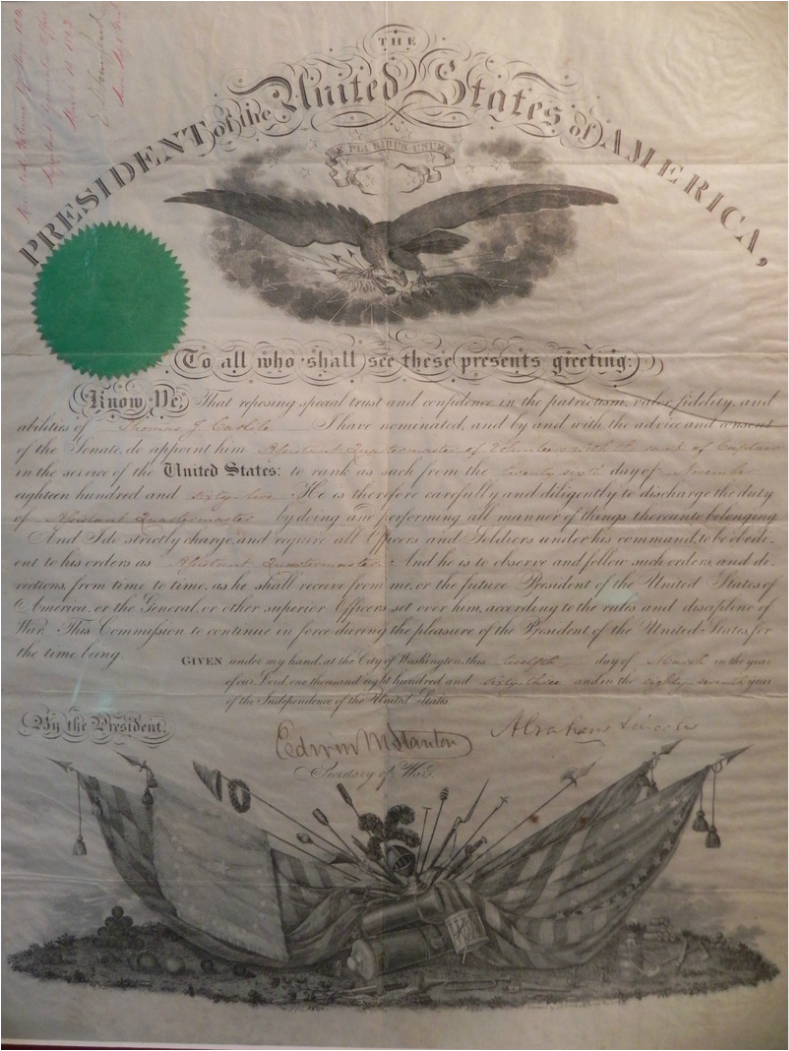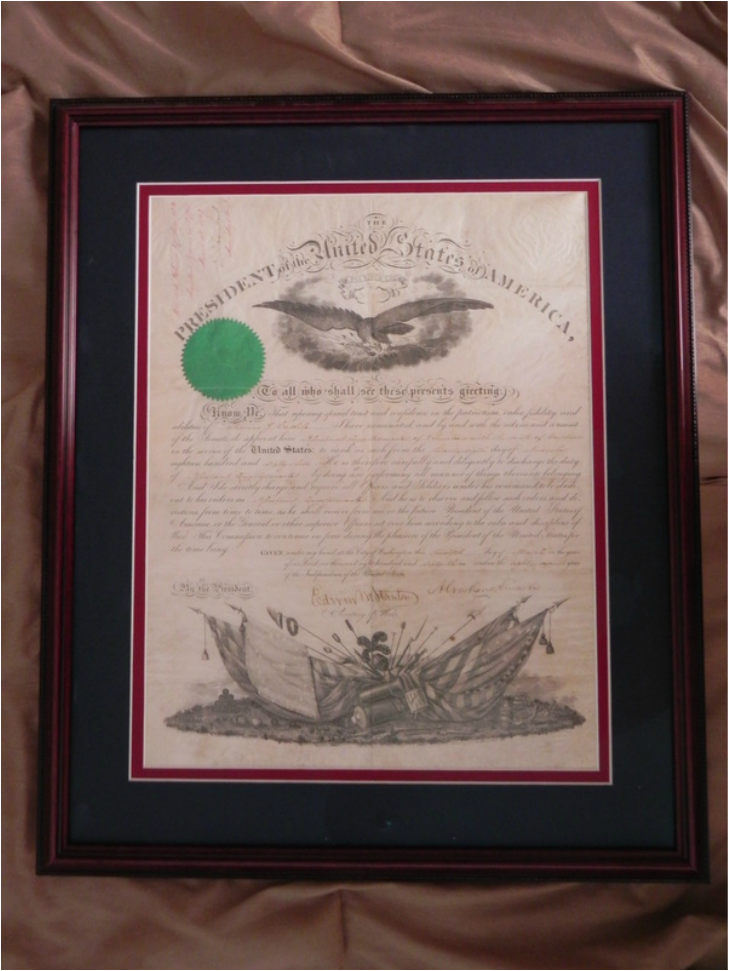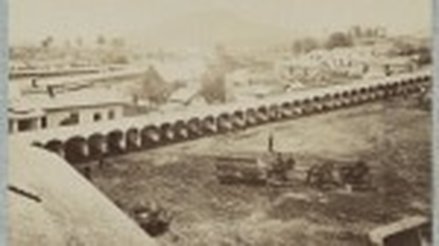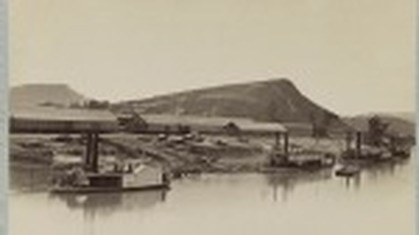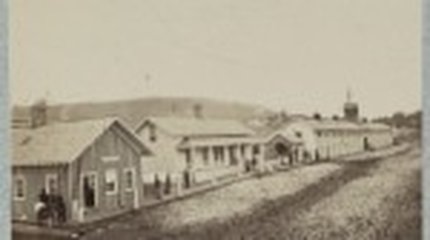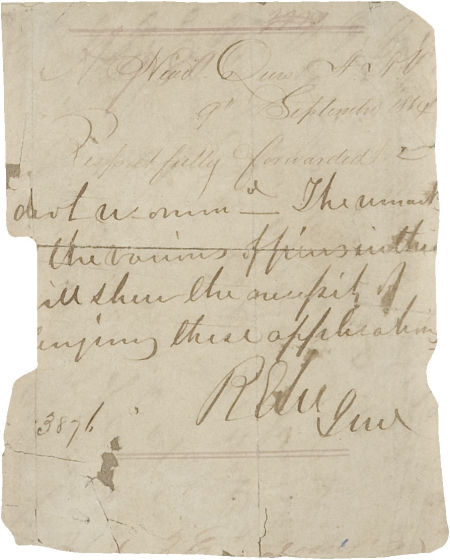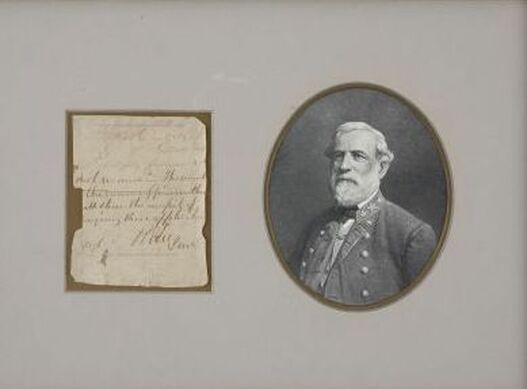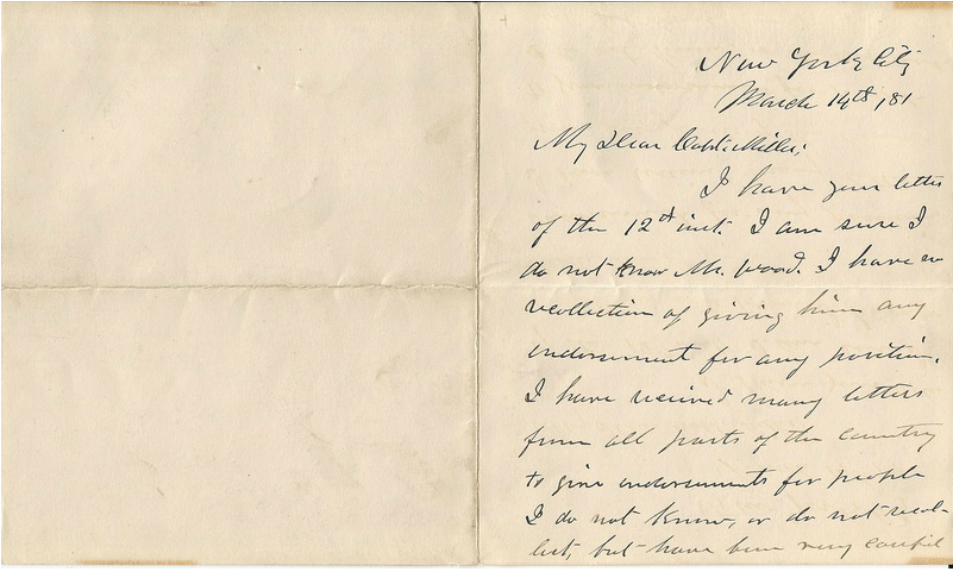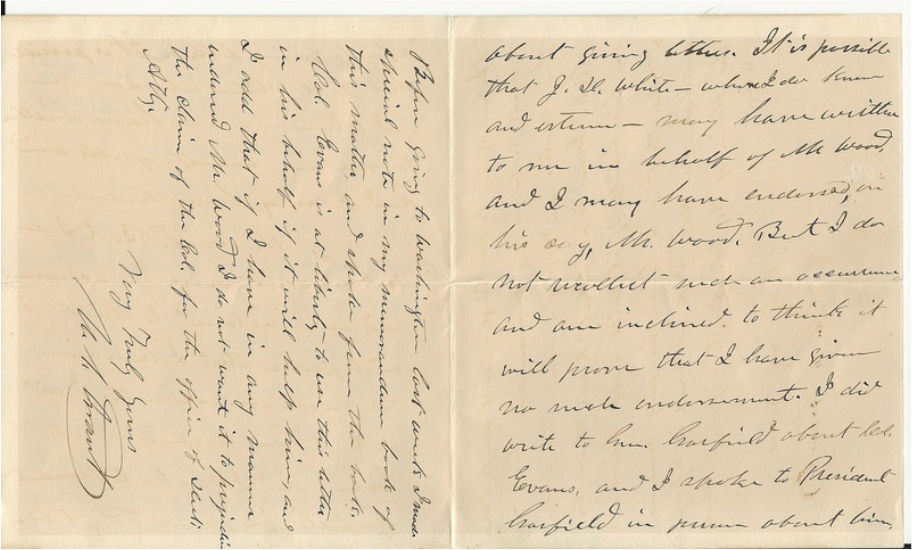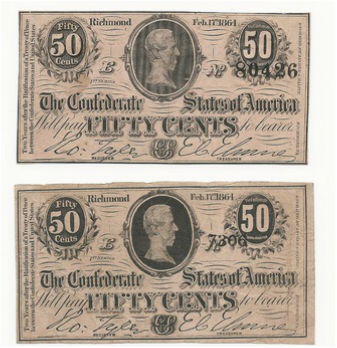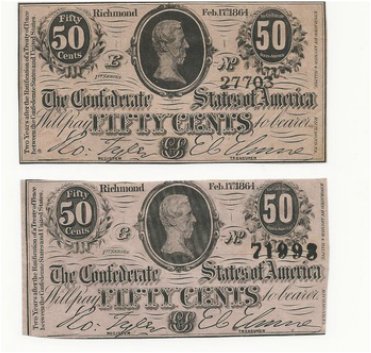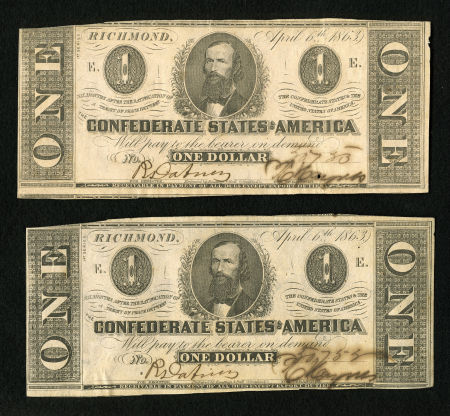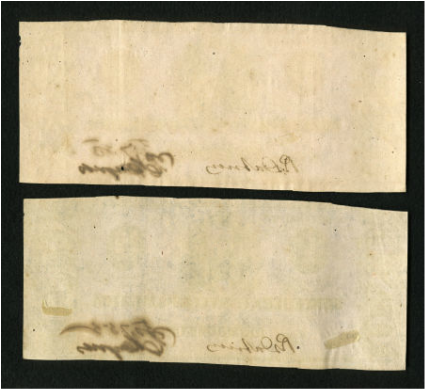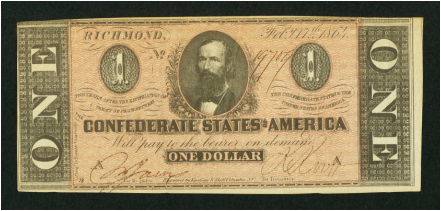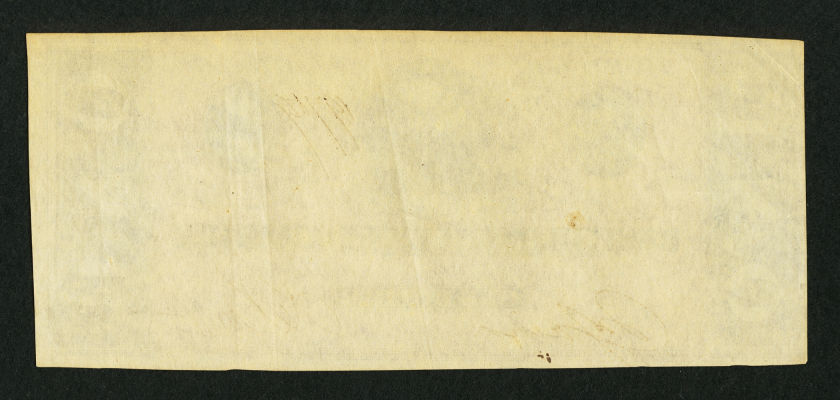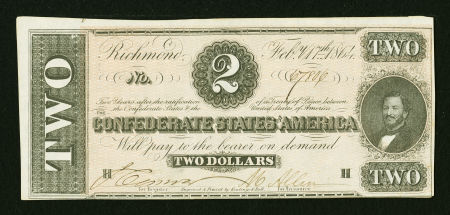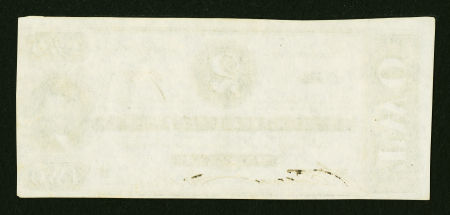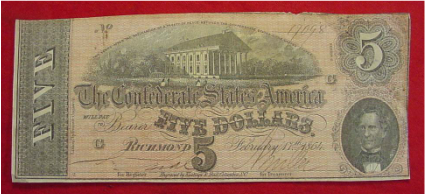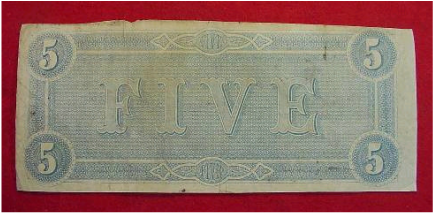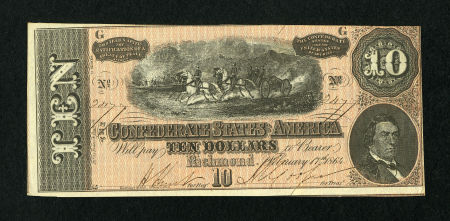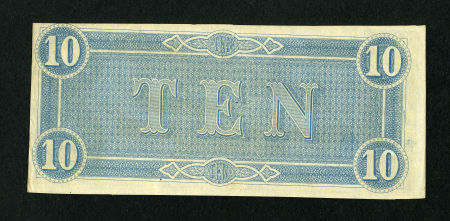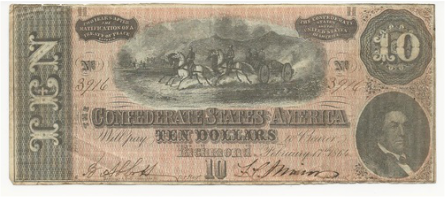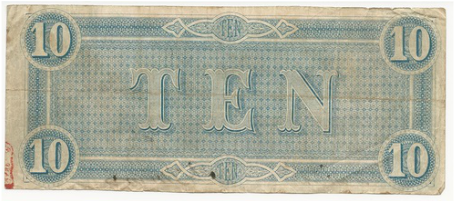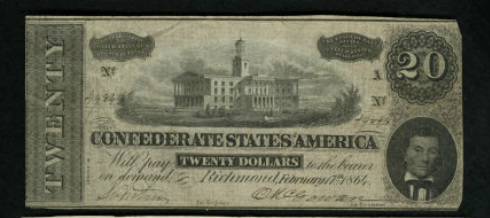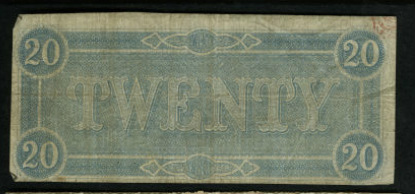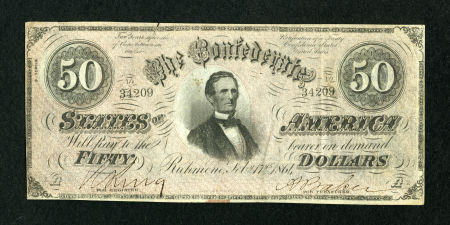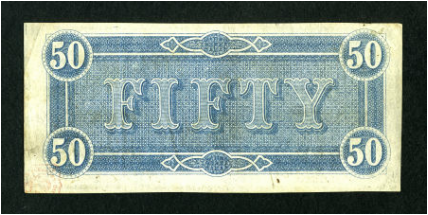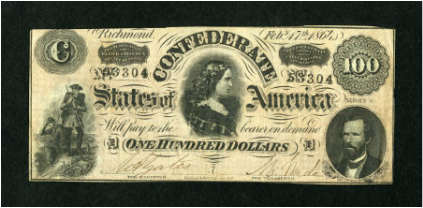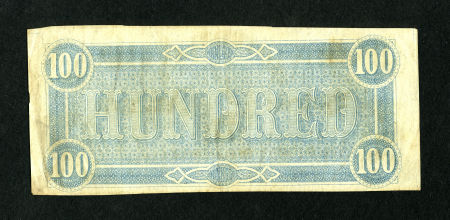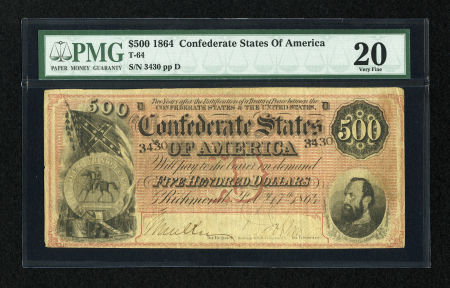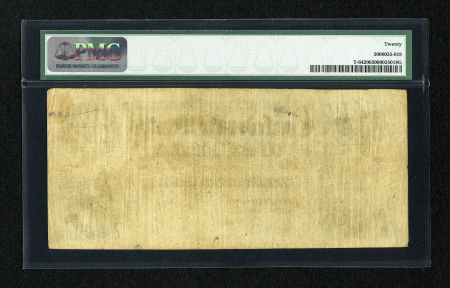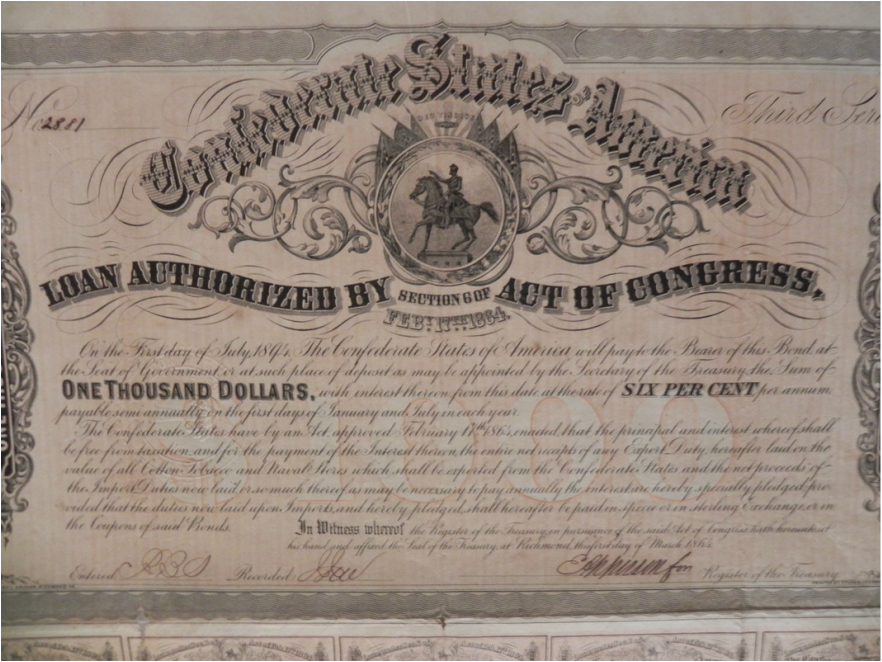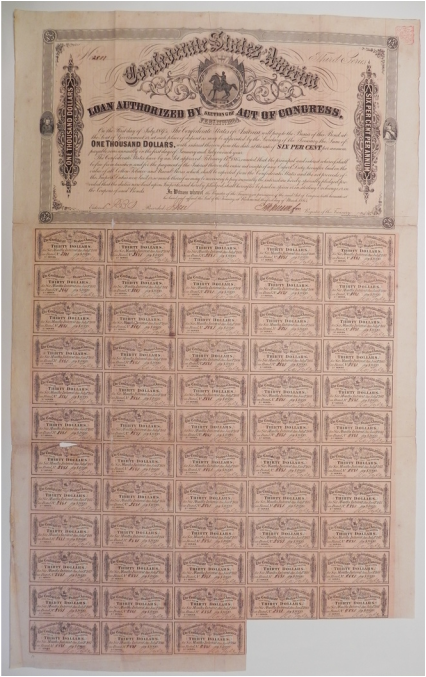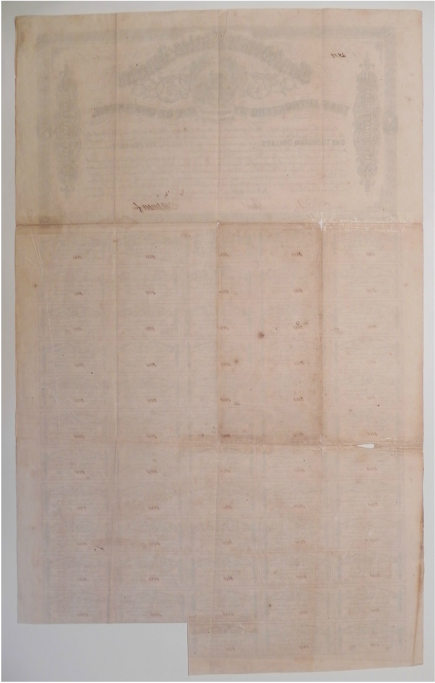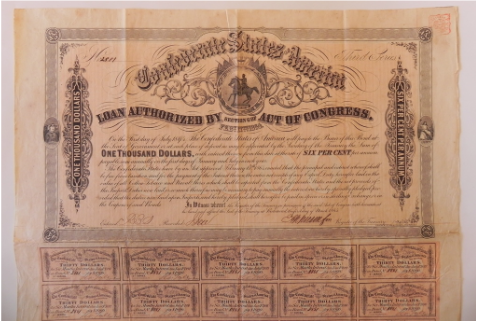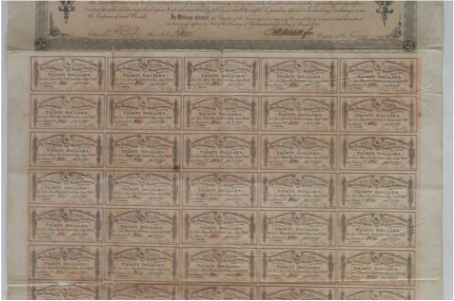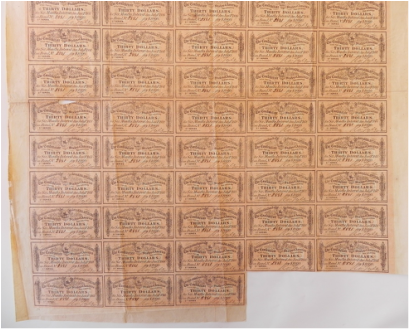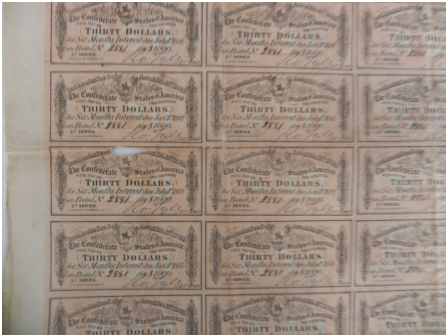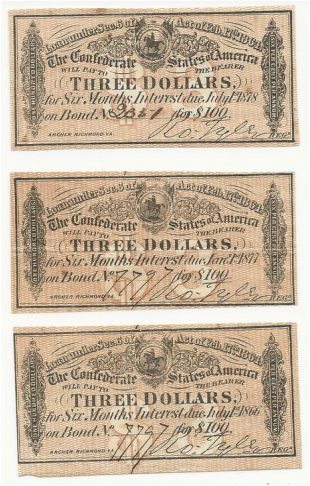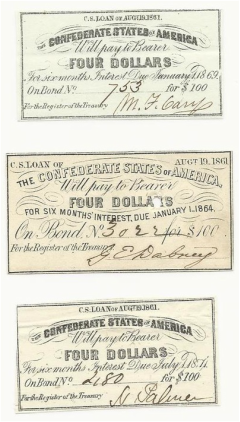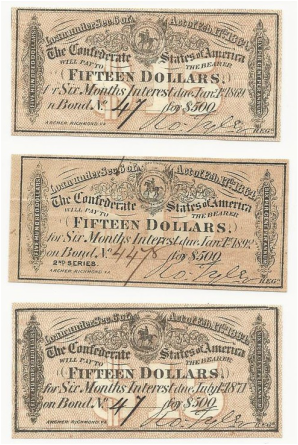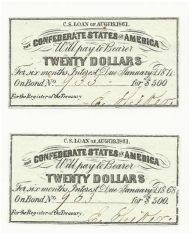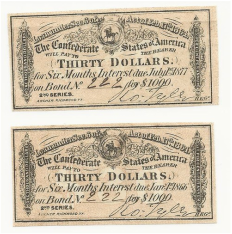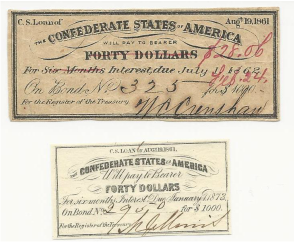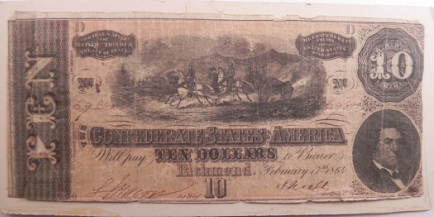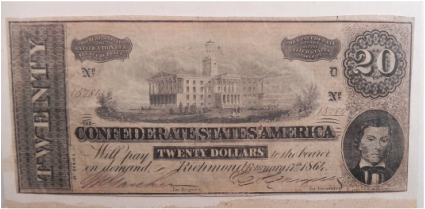Currency and Signatures
LINCOLN SIGNED DOCUMENT
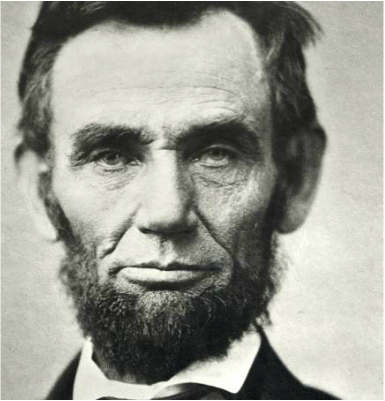
On March 4, 1861, a Kentucky-born congressman from Illinois named Abraham Lincoln was sworn in as the 16th president of the United States. The new commander-in-chief inherited a Union that was divided beyond repair--torn asunder by the decades-long debate over slavery and its future in the American republic. One month later, that division erupted into a civil war. To Abraham Lincoln fell the task of guiding the country through its darkest days. At the time of his death at the hand of an assassin's bullet, the Civil War was coming to a close and the question of slavery had been settled once and for all. In the autograph community, the most popular autograph is an Abraham Lincoln autograph. Luckily, Abraham Lincoln autographs are quite plentiful. Even with his early death, he signed many documents and letters as President, legal drafts before his Presidency and even some checks and photos. This sample is a War dated partly printed Document signed as President March 12, 1863. On vellum, the document measures 13 1/2" x 17 1/2" and has the Intact official seal affixed. This is the military appointment of Thomas J. Carlisle to " Assistant Quartermaster of Volunteers with the rank of Captain" Countersigned by Secretary of War Edwin M. Stanton. Attractive eagle and military vignette engravings at top and bottom margins.
THOMAS J. CARLISLE
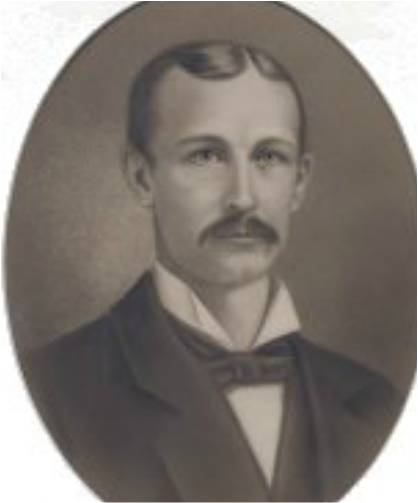 THOMAS J. CARLILE
THOMAS J. CARLILE
Born in Philadelphia, Pennsylvania, Thomas J. Carlile joined the Union Army in 1861. Carlile fought in the Battle of Chickamauga. before being transferred to the Quartermaster’s Department in Chattanooga.
"After the successful Tullahoma Campaign, Maj. Gen. William Rosecrans continued the Union offensive, aiming to force Gen. Braxton Bragg’s Confederate army out of Chattanooga. Through a series of skillful marches towards the Confederate-held city, Rosecrans forced Bragg out of Chattanooga and into Georgia. Determined to reoccupy the city, Bragg followed the Federals north, brushing with Rosecrans’ army at Davis’ Cross Roads. While they marched on September 18th, his cavalry and infantry skirmished with Union mounted infantry, who were armed with state-of-the-art Spencer repeating rifles. Fighting began in earnest on the morning of the 19th near Chickamauga Creek. Bragg’s men heavily assaulted Rosecrans’ line, but the Union line held. Fighting resumed the following day. That afternoon, eight fresh brigades from the Army of Northern Virginia under Gen. James Longstreet exploited a gap in the Federal line, driving one-third of the Rosecrans’ army, including Rosecrans himself, from the field. Only a portion of the Federal army under Gen. George Thomas, staved off disaster by holding Horseshoe Ridge against repeated assaults, allowing the Yankee's withdraw after nightfall. For this action, Thomas earned the nickname “the Rock of Chickamauga.” The defeated Union troops retreated to Chattanooga where they remained until late November".
After the Battle of Chickamauga Carlile was transferred to the Quartermaster's Department in Chattanooga and here he served the remainder of the war. After mustering out in 1865 he remained in the city. Elected mayor in 1877, Carlile took the reins of the city as it entered its brightest time since the Civil War. The administrations of Mayors Fort and Wight had improved the city’s finances and set the city on a course of prosperity. However, another threat of great devastation was about to hit the city. As other cities across the south began reporting outbreaks of yellow fever or malaria, Chattanooga began to take actions. On July 9, 1878, the mayor asked the board of aldermen to pass a law restricting wildlife from roaming the streets and asked that money be appropriated to clean the sewers. On August 24, at a specially called meeting, Mayor Carlile asked for funds to create a Citizens’ Relief Committee to begin working with the refugees flooding the city as the yellow fever epidemic spread across the south.
Due to the yellow fever epidemic becoming so wide spread in Chattanooga, the mayor and board of aldermen discontinued their regular meetings. As the city emptied of people trying to escape the spreading illness, Mayor Carlile remained and worked among the sick of the city. Mayor Carlile contracted yellow fever and died in late October. When the board of aldermen reconvened on November 5, it passed a resolution calling Mayor Carlile a hero for his efforts in the face of yellow fever.(Lived 1832 - 1878 - Information found on the Chattanooga Gov. Site).
"After the successful Tullahoma Campaign, Maj. Gen. William Rosecrans continued the Union offensive, aiming to force Gen. Braxton Bragg’s Confederate army out of Chattanooga. Through a series of skillful marches towards the Confederate-held city, Rosecrans forced Bragg out of Chattanooga and into Georgia. Determined to reoccupy the city, Bragg followed the Federals north, brushing with Rosecrans’ army at Davis’ Cross Roads. While they marched on September 18th, his cavalry and infantry skirmished with Union mounted infantry, who were armed with state-of-the-art Spencer repeating rifles. Fighting began in earnest on the morning of the 19th near Chickamauga Creek. Bragg’s men heavily assaulted Rosecrans’ line, but the Union line held. Fighting resumed the following day. That afternoon, eight fresh brigades from the Army of Northern Virginia under Gen. James Longstreet exploited a gap in the Federal line, driving one-third of the Rosecrans’ army, including Rosecrans himself, from the field. Only a portion of the Federal army under Gen. George Thomas, staved off disaster by holding Horseshoe Ridge against repeated assaults, allowing the Yankee's withdraw after nightfall. For this action, Thomas earned the nickname “the Rock of Chickamauga.” The defeated Union troops retreated to Chattanooga where they remained until late November".
After the Battle of Chickamauga Carlile was transferred to the Quartermaster's Department in Chattanooga and here he served the remainder of the war. After mustering out in 1865 he remained in the city. Elected mayor in 1877, Carlile took the reins of the city as it entered its brightest time since the Civil War. The administrations of Mayors Fort and Wight had improved the city’s finances and set the city on a course of prosperity. However, another threat of great devastation was about to hit the city. As other cities across the south began reporting outbreaks of yellow fever or malaria, Chattanooga began to take actions. On July 9, 1878, the mayor asked the board of aldermen to pass a law restricting wildlife from roaming the streets and asked that money be appropriated to clean the sewers. On August 24, at a specially called meeting, Mayor Carlile asked for funds to create a Citizens’ Relief Committee to begin working with the refugees flooding the city as the yellow fever epidemic spread across the south.
Due to the yellow fever epidemic becoming so wide spread in Chattanooga, the mayor and board of aldermen discontinued their regular meetings. As the city emptied of people trying to escape the spreading illness, Mayor Carlile remained and worked among the sick of the city. Mayor Carlile contracted yellow fever and died in late October. When the board of aldermen reconvened on November 5, it passed a resolution calling Mayor Carlile a hero for his efforts in the face of yellow fever.(Lived 1832 - 1878 - Information found on the Chattanooga Gov. Site).
QUARTERMASTER CORRALS, LANDING $ STOREHOUSES AND CORRALS AT CHATTANOOGA
ROBERT E. LEE SIGNATURE
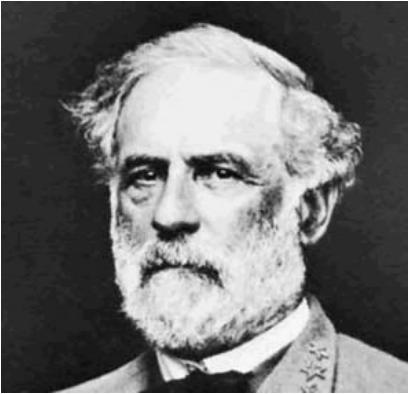
Robert E. Lee autograph on partial document. Signed "R. E. Lee Genl" framed with a Lithograph Portrait. This is a rare war dated signature of September 9, 1864, Headquarters Army of Northern Virginia. The paper was excised from a larger document with serveral words in Lee's hand above his signature and rank and measures 3.75" x 4.5. The document is in good condition with separations and chips but bright and crisp. Professionally framed with archival glass.
"Robert E. Lee (1807-1870) was one of the most talented and successful generals of the Civil War. After graduating from the U.S. Military Academy at West Point in 1846, Lee fought in the Mexican-American War where he showed his excellent leadership skills. In 1859, he was in command of the force that captured abolitionist John Brown at Harper's Ferry, Virginia. Though he was against secession, he declined Lincoln's offer to command the Union Army, instead declaring his allegiance to his home state of Virginia. Lee commanded the Confederate Army of Northern Virginia until his surrender to General Grant at Appomattox Court House on April 9, 1865.Given the almost impossible task of defeating a larger and better-equipped northern army, Lee used brilliant and aggressive tactics to defeat his enemies. At the Battle of Chancellorsville in 1863, he daringly divided his army and won a decisive victory, paving the way for his second invasion of the North. The ensuing Battle of Gettysburg, however, turned into a disaster when Lee ordered a huge frontal assault at the middle of the northern line, a doomed attack known to history as Pickett's Charge. The South never recovered from the losses of that day, and Lee spent the remainder of the war doing his best to hold off the inevitable. His surrender after the nine-month siege of Petersburg ended all major southern resistance. Lee is still remembered as a great hero of the southern cause."
Revered Confederate general who has come to symbolize the Southern cause in the Civil War. His autographs and letters can be found for any period of his life, but the most interesting are from during and after the Civil War."
"Robert E. Lee (1807-1870) was one of the most talented and successful generals of the Civil War. After graduating from the U.S. Military Academy at West Point in 1846, Lee fought in the Mexican-American War where he showed his excellent leadership skills. In 1859, he was in command of the force that captured abolitionist John Brown at Harper's Ferry, Virginia. Though he was against secession, he declined Lincoln's offer to command the Union Army, instead declaring his allegiance to his home state of Virginia. Lee commanded the Confederate Army of Northern Virginia until his surrender to General Grant at Appomattox Court House on April 9, 1865.Given the almost impossible task of defeating a larger and better-equipped northern army, Lee used brilliant and aggressive tactics to defeat his enemies. At the Battle of Chancellorsville in 1863, he daringly divided his army and won a decisive victory, paving the way for his second invasion of the North. The ensuing Battle of Gettysburg, however, turned into a disaster when Lee ordered a huge frontal assault at the middle of the northern line, a doomed attack known to history as Pickett's Charge. The South never recovered from the losses of that day, and Lee spent the remainder of the war doing his best to hold off the inevitable. His surrender after the nine-month siege of Petersburg ended all major southern resistance. Lee is still remembered as a great hero of the southern cause."
Revered Confederate general who has come to symbolize the Southern cause in the Civil War. His autographs and letters can be found for any period of his life, but the most interesting are from during and after the Civil War."
GRANT LETTER
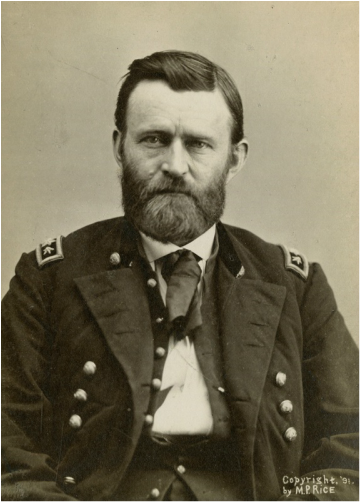
This is a Ulysses S. Grant signed letter. Two pages, 5" x 5.75", New York City, March 14, 1881. In his declining years, Civil War leader and former President Ulysses S. Grant responded to a letter written by one Captain Miller, possibly United States Senator John Franklin Miller (a major general in the Civil War), who had been appointed to Congress just ten days before this letter was penned. Miller queries the former president about the possibility of his having given an endorsement for one gentleman, as well as the prospects of another becoming a district attorney.
Grant writes, in full: "My dear Capt. Miller: I have your letter of the 12th inst. I am sure I do not know Mr. Wood. I have no recollection of giving him any endorsement for any position. I have received many letters from all parts of the country to give endorsements for people I do not know, or do not recollect, but have been very careful about giving letters. It is possible that J.D. White - whom I do know and esteem - may have written to me in behalf of Mr. Wood, and I may have endorsed, on his say, Mr. Wood. But I do not recollect such an occurrence and am inclined to think it will prove that I have given no such endorsement. I did write to Mr. Garfield about Col. Evans, and I spoke to President Garfield in person about him. Before going to Washington last week I made special note in my memorandum book of this matter and spoke from the book. Col. Evans is at liberty to use this letter in his behalf if it will help him, and I add that if I have in any manner [injured?] Mr. Wood I do not want it to prejudice the claim of the Col. for the office of Dist. Atty. Very Truly Yours, U.S. Grant." I SOLD THIS ITEM AT AUCTION JUNE 8/10
Most likely, the man Capt. Miller is asking about is Sterling Alexander Martin Wood, a former Confederate general who served as a lawyer, politician, and university professor after the war. Grant also mentions "Col. Evans," who was seeking an appointment as a district attorney at the time. We believe he is referring to Robert G. Evans, who was appointed U.S. district attorney for Minnesota by President McKinley following Garfield's assassination just six months after this letter was written. J. D. White is unknown, possibly James Douglas White, an Illinois attorney. Letter is somewhat age toned with minor fold wear. Large signature. Fine condition. i sent this off to auction in a weak moment.
Grant writes, in full: "My dear Capt. Miller: I have your letter of the 12th inst. I am sure I do not know Mr. Wood. I have no recollection of giving him any endorsement for any position. I have received many letters from all parts of the country to give endorsements for people I do not know, or do not recollect, but have been very careful about giving letters. It is possible that J.D. White - whom I do know and esteem - may have written to me in behalf of Mr. Wood, and I may have endorsed, on his say, Mr. Wood. But I do not recollect such an occurrence and am inclined to think it will prove that I have given no such endorsement. I did write to Mr. Garfield about Col. Evans, and I spoke to President Garfield in person about him. Before going to Washington last week I made special note in my memorandum book of this matter and spoke from the book. Col. Evans is at liberty to use this letter in his behalf if it will help him, and I add that if I have in any manner [injured?] Mr. Wood I do not want it to prejudice the claim of the Col. for the office of Dist. Atty. Very Truly Yours, U.S. Grant." I SOLD THIS ITEM AT AUCTION JUNE 8/10
Most likely, the man Capt. Miller is asking about is Sterling Alexander Martin Wood, a former Confederate general who served as a lawyer, politician, and university professor after the war. Grant also mentions "Col. Evans," who was seeking an appointment as a district attorney at the time. We believe he is referring to Robert G. Evans, who was appointed U.S. district attorney for Minnesota by President McKinley following Garfield's assassination just six months after this letter was written. J. D. White is unknown, possibly James Douglas White, an Illinois attorney. Letter is somewhat age toned with minor fold wear. Large signature. Fine condition. i sent this off to auction in a weak moment.
CONFEDERATE CURRENCY AND BONDS
FEB. 17 1864 50 CENTS CONFEDERATE
Confederate currency, 50 cents, February 17, 1864 . Profile head of Jefferson Davis, president of the Confederate States. This is the same design as used on the 10 cent postage stamp and was engraved by Halpin. printed signatures. This note was printed with black ink on pink paper. There is no design on the back.The 50 cent notes are the only regularly issued Confederate notes to bear printed signatures although there was a demand for printed signatures on higher values as well. This was hardly an unreasonable demand when we consider the amount of labor and time spent in signing two signatures to millions of pieces of paper money. The closest parallel is that the Continental Currency of the Revolution which fared no better although it was similarly hand signed. The idea of hand signing notes was to help prevent counterfeiting but since such a large number of persons was required to sign all of the notes, the mass of signatures merely became confusing.
Inscriptions: "Six months after the ratification of a treaty of peace between the Confederate States and United States, The Confederate States of America will pay Fifty Cents to bearer/ Richmond April 6th."
If the serial number of your note is 6850 or 83999 then what you have is a reproduction with no collector value.
(Reference: Confederate States Paper Money, Civil War Currency from The South-History, Identification and Pricing. Edited by George S. Cuhaj, page 70; Comprehensive Catalog of Confederate Paper Money By: Grover C. Criswell, 11th edition - T63)
.
Inscriptions: "Six months after the ratification of a treaty of peace between the Confederate States and United States, The Confederate States of America will pay Fifty Cents to bearer/ Richmond April 6th."
If the serial number of your note is 6850 or 83999 then what you have is a reproduction with no collector value.
(Reference: Confederate States Paper Money, Civil War Currency from The South-History, Identification and Pricing. Edited by George S. Cuhaj, page 70; Comprehensive Catalog of Confederate Paper Money By: Grover C. Criswell, 11th edition - T63)
.
APRIL 6TH 1863 $1 CONFEDERATE BILL
Two Confederate 1863 one dollar notes with consecutive serial numbers. This note has a bust of Confederate senator Clement C. Clay, Confederate Senator from Alabama. Black print on Pink paper.. There is no design on the back. Both of these notes have sustained one fold but are quite bright. Currency was authorized March 23, 1863, issued April 6, 1863, Date is printed, serial number is hand inscribed, signature is hand signed.
Inscriptions: "Six months after the ratification of a treaty of peace between the Confederate States & the United States of America, The Confederate States of America will pay to the bearer on demand One Dollar/ Richmond, April 6th 1863/ Receivable in payment of all dues except export duties/ Engraved by Keatinge & Ball Columbia, S.C."
If the serial number of your note is 1468 or 18094 then what you have is a reproduction with no collector value.
(Reference: Confederate States Paper Money, Civil War Currency from The South-History, Identification and Pricing. Edited by George S. Cuhaj, page 63; Comprehensive Catalog of Confederate Paper Money By: Grover C. Criswell, 11th edition - T62)
Inscriptions: "Six months after the ratification of a treaty of peace between the Confederate States & the United States of America, The Confederate States of America will pay to the bearer on demand One Dollar/ Richmond, April 6th 1863/ Receivable in payment of all dues except export duties/ Engraved by Keatinge & Ball Columbia, S.C."
If the serial number of your note is 1468 or 18094 then what you have is a reproduction with no collector value.
(Reference: Confederate States Paper Money, Civil War Currency from The South-History, Identification and Pricing. Edited by George S. Cuhaj, page 63; Comprehensive Catalog of Confederate Paper Money By: Grover C. Criswell, 11th edition - T62)
FEB. 17TH 1864 $1 CONFEDERATE BILL
This $1 Confederate note has a pink overprint and a picture of Clement C. Clay in the center. This note was printed on plain paper with pink and black ink. There is no design on the back. By the time the Confederacy issued the 1864 $1.00 note it was virtually worthless because of inflation. Although the pricing of original notes don't depict this a $1.00 1864 note in good condition is much rarer than the $500.00 note. The $500.00 note is more appealing in that it has an image of Stonewall Jackson and a Confederate flag.
Inscriptions: "Two years after the ratification of a treaty of peace between the Confederate States & The United States of America, The Confederate States of America will pay to the bearer on demand One Dollar/ Richmond Feb. 17th 1864/ Engraved & Printed by Keatinge & Ball"
If the serial number of your note is 3691, 6171, 24890, 32984, 42507, 76280, 82129, 83383, or 85087 then what you have is a reproduction with no collector value.
(Reference: Confederate States Paper Money, Civil War Currency from The South-History, Identification and Pricing. Edited by George S. Cuhaj, page 63; Comprehensive Catalog of Confederate Paper Money By: Grover C. Criswell, 11th edition - T62)
FEB. 17TH 1864 $2 CONFEDERATE BILL
This $2 Confederate note has a pink overprint and a Large "2" in the center. Depicts Judah P. Benjamin, Confederate Attorney General and Secretary of War. Date is printed, serial number is hand inscribed, signature is hand signed. There is no design on the back. Printing: "Lithog'd by Evans & Cogswell" and "Engraved by Keatinge & Ball, Columbia, S. C.".
Inscriptions: "Two years after the ratification of a treaty of peace between the Confederate States & the United States of America, The Confederate States of America will pay to the bearer on demand Two Dollars/ Richmond Feb. 17th 1864/ Engraved & Printed by Keatinge & Ball"
If the serial number of your note is 4505, 18491, 32098, 34098, 37544, 48840, 74585, 93609, 94505, or 98840 then what you have is a reproduction with no collector value.
(Reference: Confederate States Paper Money, Civil War Currency from The South-History, Identification and Pricing. Edited by George S. Cuhaj, page 69; Comprehensive Catalog of Confederate Paper Money By: Grover C. Criswell, 11th edition - T70)
Inscriptions: "Two years after the ratification of a treaty of peace between the Confederate States & the United States of America, The Confederate States of America will pay to the bearer on demand Two Dollars/ Richmond Feb. 17th 1864/ Engraved & Printed by Keatinge & Ball"
If the serial number of your note is 4505, 18491, 32098, 34098, 37544, 48840, 74585, 93609, 94505, or 98840 then what you have is a reproduction with no collector value.
(Reference: Confederate States Paper Money, Civil War Currency from The South-History, Identification and Pricing. Edited by George S. Cuhaj, page 69; Comprehensive Catalog of Confederate Paper Money By: Grover C. Criswell, 11th edition - T70)
FEB. 17 1864 $5 CONFEDERATE BILL
This $5.00 Confederate note has the Confederate Capitol at Richmond, Virginia in the center of the note. In the lower right hand side is the likeness of C.G. Memminger who served as the Confederate Secretary of the Treasury and was the key man in production of Confederate paper money. This note was printed on plain paper with pink and black ink on the front and blue ink on the back with FIVE in large letters. The note is correctly hand signed and numbered.
Inscriptions: "Two years after the ratification of a treaty of peace between the Confederate States & the United States, The Confederate States of America will pay to bearer Five Dollars/ Richmond February 17th 1864/ Litho by Evans & Cogswell/ Engraved by Keatinge & Ball Columbia SC"
If the serial number of your note is 1138, 18262, 19640, 23580, 45806, 46147, 47333, 50243, 68771, and 76280 then what you have is a reproduction with no collector value.
(Reference: Confederate States Paper Money, Civil War Currency from The South-History, Identification and Pricing. Edited by George S. Cuhaj, page 69; Comprehensive Catalog of Confederate Paper Money By: Grover C. Criswell, 11th edition - T69)
Inscriptions: "Two years after the ratification of a treaty of peace between the Confederate States & the United States, The Confederate States of America will pay to bearer Five Dollars/ Richmond February 17th 1864/ Litho by Evans & Cogswell/ Engraved by Keatinge & Ball Columbia SC"
If the serial number of your note is 1138, 18262, 19640, 23580, 45806, 46147, 47333, 50243, 68771, and 76280 then what you have is a reproduction with no collector value.
(Reference: Confederate States Paper Money, Civil War Currency from The South-History, Identification and Pricing. Edited by George S. Cuhaj, page 69; Comprehensive Catalog of Confederate Paper Money By: Grover C. Criswell, 11th edition - T69)
FEB. 17TH 1864 $10 CONFEDERATE BILL
This specimen of a Confederate $10.00 note has nice color and is about uncirculated. The vignette includes field artillery being pulled by horses. The portrait at lower right is Robert M.T. Hunter (1809-1887). He was a secretary of state for the Confederacy for a brief time and a senator. Prior to the war, Hunter served as a U.S. congressman and senator from Virginia. This note was printed on plain paper with pink and black ink on the front and blue web reverse with denomination. Seventh issue, February 17, 1864.
Inscriptions: "Two years after the ratification of a treaty of peace between the Confederate States and the United States of America, the Confederate States of America will pay Ten Dollars to bearer/ Richmond February 17th 1864/ Evans & Cogswell/ Keatinge & Ball Columbia SC"
If the serial number of your note is 8470, 9825, 14077, 22462, 31680, 32515, 35342, 39911, 40620, 40679, 45447, 45956, 49987, 55411, 66037, 83185, or 96636 then what you have is a reproduction with no collector value.
(Reference: Confederate States Paper Money, Civil War Currency from The South-History, Identification and Pricing. Edited by George S. Cuhaj, page 68; Comprehensive Catalog of Confederate Paper Money By: Grover C. Criswell, 11th edition - T68)
Inscriptions: "Two years after the ratification of a treaty of peace between the Confederate States and the United States of America, the Confederate States of America will pay Ten Dollars to bearer/ Richmond February 17th 1864/ Evans & Cogswell/ Keatinge & Ball Columbia SC"
If the serial number of your note is 8470, 9825, 14077, 22462, 31680, 32515, 35342, 39911, 40620, 40679, 45447, 45956, 49987, 55411, 66037, 83185, or 96636 then what you have is a reproduction with no collector value.
(Reference: Confederate States Paper Money, Civil War Currency from The South-History, Identification and Pricing. Edited by George S. Cuhaj, page 68; Comprehensive Catalog of Confederate Paper Money By: Grover C. Criswell, 11th edition - T68)
FEB. 17TH 1864 $10 CONFEDERATE BILL
Note depicts horses pulling a cannon at center, and R. M. T. Hunter, Confederate Secretary of State and Senator, at right. This note was printed on plain paper with pink and black ink on the front and blue ink on the back with TEN in large letters. This high denomination 1864 note reflects the hyper-inflation gripping the Confederacy in 1864. Date is printed, serial number is hand inscribed, signature is hand signed. Printing: "Pt'd by Evans & Cogswell" and "Keatinge & Ball, Columbia, S. C."
Inscriptions: "Two years after the ratification of a treaty of peace between the Confederate States and the United States of America, the Confederate States of America will pay Ten Dollars to bearer/ Richmond February 17th 1864/ Evans & Cogswell/ Keatinge & Ball Columbia SC"
If the serial number of your note is 8470, 9825, 14077, 22462, 31680, 32515, 35342, 39911, 40620, 40679, 45447, 45956, 49987, 55411, 66037, 83185, or 96636 then what you have is a reproduction with no collector value. Please do not contact us if you have a reproduction
(Reference: Confederate States Paper Money, Civil War Currency from The South-History, Identification and Pricing. Edited by George S. Cuhaj, page 68; Comprehensive Catalog of Confederate Paper Money By: Grover C. Criswell, 11th edition - T68)
Inscriptions: "Two years after the ratification of a treaty of peace between the Confederate States and the United States of America, the Confederate States of America will pay Ten Dollars to bearer/ Richmond February 17th 1864/ Evans & Cogswell/ Keatinge & Ball Columbia SC"
If the serial number of your note is 8470, 9825, 14077, 22462, 31680, 32515, 35342, 39911, 40620, 40679, 45447, 45956, 49987, 55411, 66037, 83185, or 96636 then what you have is a reproduction with no collector value. Please do not contact us if you have a reproduction
(Reference: Confederate States Paper Money, Civil War Currency from The South-History, Identification and Pricing. Edited by George S. Cuhaj, page 68; Comprehensive Catalog of Confederate Paper Money By: Grover C. Criswell, 11th edition - T68)
FEB. 17TH 1864 $20 CONFEDERATE BILL
This $20 Confederate note has a picture of the Tennessee State Capitol in the center with a pink overprint. In the lower right corner is a picture of Alexander H. Stephens. Blue back with "TWENTY" in large letters.
Inscriptions: "Six months after the ratification of a treaty of peace between/ Two years after the ratification of a treaty of peace between/ The Confederate States of America will pay Twenty Dollars to the bearer on demand/ Richmond, February 17th, 1864/ Keatinge & Ball Columbia SC"
If the serial number of your note is 1372, 2625, 10482, 13410, 22224, 23483, 35021, 46410, 56809, 68327, 76627, or 93941 then what you have is a reproduction with no collector value. Please do not contact us if you have a reproduction.
(Reference: Confederate States Paper Money, Civil War Currency from The South-History, Identification and Pricing. Edited by George S. Cuhaj, page 68; Comprehensive Catalog of Confederate Paper Money By: Grover C. Criswell, 11th edition - T67)
Inscriptions: "Six months after the ratification of a treaty of peace between/ Two years after the ratification of a treaty of peace between/ The Confederate States of America will pay Twenty Dollars to the bearer on demand/ Richmond, February 17th, 1864/ Keatinge & Ball Columbia SC"
If the serial number of your note is 1372, 2625, 10482, 13410, 22224, 23483, 35021, 46410, 56809, 68327, 76627, or 93941 then what you have is a reproduction with no collector value. Please do not contact us if you have a reproduction.
(Reference: Confederate States Paper Money, Civil War Currency from The South-History, Identification and Pricing. Edited by George S. Cuhaj, page 68; Comprehensive Catalog of Confederate Paper Money By: Grover C. Criswell, 11th edition - T67)
FEB. 17TH 1864 $50 CONFEDERATE BILL
Note depicts Jefferson Davis, Confederate President, black with redish overprint, blue back with "FIFTY" in large letters. This high denomination 1864 note reflects the hyper-inflation gripping the Confederacy in 1864. Date is printed, serial number is hand stamped, signature is hand signed.
Inscriptions: "Two years after the ratification of a treaty of peace between the Confederate States and the United States, The Confederate States of America will pay to the bearer on demand Fifty Dollars/ Richmond, Feb. 17th, 1864/ Keatinge & Ball Columbia, SC"
If the serial number of your note is 5670, 5920, 11999, 14949, 24791, 25674, 50935, 59204, 61891, 72104, or 77114 then what you have is a reproduction with no collector value. .
(Reference: Confederate States Paper Money, Civil War Currency from The South-History, Identification and Pricing. Edited by George S. Cuhaj, page 61; Comprehensive Catalog of Confederate Paper Money By: Grover C. Criswell, 11th edition - T66)
Inscriptions: "Two years after the ratification of a treaty of peace between the Confederate States and the United States, The Confederate States of America will pay to the bearer on demand Fifty Dollars/ Richmond, Feb. 17th, 1864/ Keatinge & Ball Columbia, SC"
If the serial number of your note is 5670, 5920, 11999, 14949, 24791, 25674, 50935, 59204, 61891, 72104, or 77114 then what you have is a reproduction with no collector value. .
(Reference: Confederate States Paper Money, Civil War Currency from The South-History, Identification and Pricing. Edited by George S. Cuhaj, page 61; Comprehensive Catalog of Confederate Paper Money By: Grover C. Criswell, 11th edition - T66)
FEB. 17TH 1864 $100 CONFEDERATE BILL
Note depicts "Women of the South" as represented by Lucy H. Pickens at center, the "southern belle", two soldiers holding rifles at left, and Geo. W. Randolph, Confederate Secretary of War and General, at right, black with reddish overprint, blue back with "HUNDRED" in large letters. This high denomination 1864 note reflects the hyper-inflation gripping the Confederacy in 1864. Date is printed, serial number is hand stamped, signature is hand signed.
Inscriptions: "Two years after the ratification of a treaty of peace between the Confederate States and the United States of America, The Confederate States of America will pay to the bearer on demand One Hundred Dollars/ Richmond Feb. 17th 1864/ Keatinge & Ball Columbia SC"
If the serial number of your note is 801, 4398, 20396, 33193, 41567, 44248, 47128, 49987, 79243, 85117, or 92685 then what you have is a reproduction with no collector value. Please do not contact us if you have a reproduction.
(Reference: Confederate States Paper Money, Civil War Currency from The South-History, Identification and Pricing. Edited by George S. Cuhaj, page 67; Comprehensive Catalog of Confederate Paper Money By: Grover C. Criswell, 11th edition - T65)
Inscriptions: "Two years after the ratification of a treaty of peace between the Confederate States and the United States of America, The Confederate States of America will pay to the bearer on demand One Hundred Dollars/ Richmond Feb. 17th 1864/ Keatinge & Ball Columbia SC"
If the serial number of your note is 801, 4398, 20396, 33193, 41567, 44248, 47128, 49987, 79243, 85117, or 92685 then what you have is a reproduction with no collector value. Please do not contact us if you have a reproduction.
(Reference: Confederate States Paper Money, Civil War Currency from The South-History, Identification and Pricing. Edited by George S. Cuhaj, page 67; Comprehensive Catalog of Confederate Paper Money By: Grover C. Criswell, 11th edition - T65)
February 17th 1864 $500 Confederate Bill
This is a beautiful and although not rare, one of the most desirable of all Confederate notes. This is the February 17, 1864 production of the Confederate $500 note. It has always been a favorite for collectors because of the high denomination and the fact that it has the likeness of General Stonewall Jackson on one side and on the other is the Confederate battle flag and the Confederate seal atop war implements. It has nice clear ink signatures and printed numbers which is correct for this style of note. This one has the serial number of 20151 and has attractive pink and black color and a fine look. There is no design on the back. PMG Very Fine EPQ.
Inscriptions: "Two years after the ratification of a treaty of peace between the Confederate States & The United States, The Confederate States of America will pay to the bearer on demand Five Hundred Dollars/ Richmond Feb. 17th 1864/ Keatinge & Ball Columbia SC".
If the serial number of your note is 393, 9229, 14682, 16599, 16760, 18278, 18935, 19834, 21130, 26326, 26949, 33546, 36776, 67935, or 82210 then what you have is a reproduction with no collector value.
(Reference: Confederate States Paper Money, Civil War Currency from The South-History, Identification and Pricing. Edited by George S. Cuhaj, page 66; Comprehensive Catalog of Confederate Paper Money By: Grover C. Criswell, 11th edition - T72)
Inscriptions: "Two years after the ratification of a treaty of peace between the Confederate States & The United States, The Confederate States of America will pay to the bearer on demand Five Hundred Dollars/ Richmond Feb. 17th 1864/ Keatinge & Ball Columbia SC".
If the serial number of your note is 393, 9229, 14682, 16599, 16760, 18278, 18935, 19834, 21130, 26326, 26949, 33546, 36776, 67935, or 82210 then what you have is a reproduction with no collector value.
(Reference: Confederate States Paper Money, Civil War Currency from The South-History, Identification and Pricing. Edited by George S. Cuhaj, page 66; Comprehensive Catalog of Confederate Paper Money By: Grover C. Criswell, 11th edition - T72)
CONFEDERATE BOND
Perhaps the most impressive and colorful of all Confederate bonds. This $1,000 Confederate States of America bond was a "Loan Authorized by Act of Congress," February 17, 1864.The vignette is of the Confederate seal bearing an image of George Washington on a horse with Confederate flags and the motto “DEO VINDICE.” Each of the four corners of the border has an intertwined “CSA”. Halfway down the left border is a representation of Justice while the opposite side has Liberty. A tiny version of this image is repeated on each of its $30 coupons. When the Confederacy issued savings bonds they had these coupons attached. When the redemption date on the coupon arrived you could cash in the coupon for your interest payment. These coupons were to be payment of the 6 percent interest due every six months. This bond with it's pink to red background is considered to be one of the most attractive of all the Confederate bond issues. As you can see this one has the original ink serial number hand written on the paper and the printed signature just as it should be. First two coupons have been redeemed (Jan.1865 and July 1865),as would be expected. Of course, by the time the redemption date of the third coupon rolled around, the Confederate States no longer existed. The bond is from the Third Series and is numbered 2881. Attached to the bond are 58 redemption tickets.The bond was engraved by J. Archer, of Richmond, Va. and printed by Evans & Cogswell, Columbia, S.C. The item is in good condition with clear printing and signatures. Some small tears and wear as shown in the picture. There is also some foxing and discolorations along the edges of the document. It measures 17.5 inches by 27.5 inches overall.
COUPONS CLIPPED FROM CONFEDERATE BONDS
There are generally two different styles of Confederate States of America (C.S.A.) Bonds. Although they are all generally called bonds, they are really bonds and certificates. The major difference is that bonds have coupons attached at the bottom and certificates do not. This picture shows some of the coupons cut from bonds.
All bonds were printed with coupons attached. These coupons were cut off one at a time every six months and redemmed at the CSA Treasury. The coupons vary from $2 each for some $50 bonds up to $300 each for one of the $10,000 bonds. There were 13 official issues of Confederate Bonds.
Each bond or certificate either had two signatures and 1 set of initials or 1 signature and 2 sets of initials. The signature or initial on the left is from the person who "entered" the bond. The initials underneath on the left is from the person who "recorded" the bond in the treasury books, and the signature on the right is from the "Register of the Treasury". The signature on the right is sometimes "Ro. Tyler" who was the son of John Tyler, 10th President of the United States. All bonds and certificates have Genuine Signatures. In addition, the coupons are also signed. The ink used is very corrosive and generally has eaten into the paper over the last 150 years. It usually looks medium to dark brown in color and may have gone completely through to the back.
All bonds and certificates have serial numbers in usually two places. In addition, all bonds also have the serial numbers on each coupon. The serial numbers are usually hand written but some are stamped. The color of the ink may or may not be the same color as the signatures.
The paper used is usually white or brownish-pink. The white paper also comes in both thick and thin varieties. Some paper may have watermarks or colored threads in them. The watermarked bonds are generally rare.
Nearly every bond and certificate has a blank back, however, there are a few exceptions. In addition, the backs were also used by CSA officers and some may have writing on the back which will give a little more history regarding that specific bond (and a higher collector value)
All bonds were printed with coupons attached. These coupons were cut off one at a time every six months and redemmed at the CSA Treasury. The coupons vary from $2 each for some $50 bonds up to $300 each for one of the $10,000 bonds. There were 13 official issues of Confederate Bonds.
Each bond or certificate either had two signatures and 1 set of initials or 1 signature and 2 sets of initials. The signature or initial on the left is from the person who "entered" the bond. The initials underneath on the left is from the person who "recorded" the bond in the treasury books, and the signature on the right is from the "Register of the Treasury". The signature on the right is sometimes "Ro. Tyler" who was the son of John Tyler, 10th President of the United States. All bonds and certificates have Genuine Signatures. In addition, the coupons are also signed. The ink used is very corrosive and generally has eaten into the paper over the last 150 years. It usually looks medium to dark brown in color and may have gone completely through to the back.
All bonds and certificates have serial numbers in usually two places. In addition, all bonds also have the serial numbers on each coupon. The serial numbers are usually hand written but some are stamped. The color of the ink may or may not be the same color as the signatures.
The paper used is usually white or brownish-pink. The white paper also comes in both thick and thin varieties. Some paper may have watermarks or colored threads in them. The watermarked bonds are generally rare.
Nearly every bond and certificate has a blank back, however, there are a few exceptions. In addition, the backs were also used by CSA officers and some may have writing on the back which will give a little more history regarding that specific bond (and a higher collector value)
STARTER CURRENCY SET
Sample of notes that have been abused over the years. They are torn in spots and glued onto cardboard for display. The Confederate notes were plentiful and useless after the war for decades and shown little historical respect. Still, they are attractive and representative of the short lived Confederate States of America.
